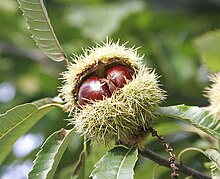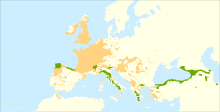Spanish chestnut
| Sweet chestnut | |
|---|---|
 |
|
| Sweet chestnut fruit | |
| Scientific classification | |
| Kingdom: | Plantae |
| (unranked): | Angiosperms |
| (unranked): | Eudicots |
| (unranked): | Rosids |
| Order: | Fagales |
| Family: | Fagaceae |
| Genus: | Castanea |
| Species: | C. sativa |
| Binomial name | |
|
Castanea sativa Mill. |
|
 |
|
| Distribution map | |
| Nutritional value per 100 g (3.5 oz) | |
|---|---|
| Energy | 891 kJ (213 kcal) |
|
45.54 g
|
|
| Dietary fiber | 8.1 g |
|
2.26 g
|
|
| Saturated | 0.425 g |
| Monounsaturated | 0.780 g |
| Polyunsaturated | 0.894 g |
|
2.42 g
|
|
| Tryptophan | 0.027 g |
| Threonine | 0.086 g |
| Isoleucine | 0.095 g |
| Leucine | 0.143 g |
| Lysine | 0.143 g |
| Methionine | 0.057 g |
| Cystine | 0.077 g |
| Phenylalanine | 0.102 g |
| Tyrosine | 0.067 g |
| Valine | 0.135 g |
| Arginine | 0.173 g |
| Histidine | 0.067 g |
| Alanine | 0.161 g |
| Aspartic acid | 0.417 g |
| Glutamic acid | 0.312 g |
| Glycine | 0.124 g |
| Proline | 0.127 g |
| Serine | 0.121 g |
| Vitamins | |
| Vitamin A equiv. |
(0%)
1 μg |
| Thiamine (B1) |
(21%)
0.238 mg |
| Riboflavin (B2) |
(14%)
0.168 mg |
| Niacin (B3) |
(8%)
1.179 mg |
| Pantothenic acid (B5) |
(10%)
0.509 mg |
| Vitamin B6 |
(29%)
0.376 mg |
| Folate (B9) |
(16%)
62 μg |
| Vitamin B12 |
(0%)
0.00 μg |
| Vitamin C |
(52%)
43.0 mg |
| Minerals | |
| Calcium |
(3%)
27 mg |
| Iron |
(8%)
1.01 mg |
| Magnesium |
(9%)
32 mg |
| Manganese |
(45%)
0.952 mg |
| Phosphorus |
(13%)
93 mg |
| Potassium |
(11%)
518 mg |
| Sodium |
(0%)
3 mg |
| Zinc |
(5%)
0.52 mg |
| Other constituents | |
| Water | 48.65 g |
|
|
|
|
|
| Percentages are roughly approximated using US recommendations for adults. Source: USDA Nutrient Database |
|
Castanea sativa, or sweet chestnut, is a species of flowering plant in the family Fagaceae, native to Europe and Asia Minor, and widely cultivated throughout the temperate world. A substantial, long-lived deciduous tree, it produces an edible seed, the chestnut, which has been used in cooking since ancient times.
The tree is commonly called the "chestnut", or "sweet chestnut" to distinguish it from the horse chestnut Aesculus hippocastanum, to which it is only distantly related. Other common names include "Spanish chestnut", "Portuguese chestnut" and "marron" (French for "chestnut"). The Latin sativa means "cultivated by humans". Some selected varieties are smaller and more compact in growth yielding earlier in life with different ripening time: the Marigoule, the Marisol and the Maraval.
C. sativa attains a height of 20–35 m (66–115 ft) with a trunk often 2 m (7 ft) in diameter. The bark often has a net-shaped (retiform) pattern with deep furrows or fissures running spirally in both directions up the trunk. The oblong-lanceolate, boldly toothed leaves are 16–28 cm (6–11 in) long and 5–9 cm (2–4 in) broad.
The flowers of both sexes are borne in 10–20 cm (4–8 in) long, upright catkins, the male flowers in the upper part and female flowers in the lower part. In the northern hemisphere, they appear in late June to July, and by autumn, the female flowers develop into spiny cupules containing 3-7 brownish nuts that are shed during October. The female flowers eventually form a spiky sheath that deters predators from the seed. Some cultivars ('Marron de Lyon', 'Paragon' and some hybrids) produce only one large nut per cupule, rather than the usual two to four nuts of edible, though smaller, size.
The tree requires a mild climate and adequate moisture for good growth and a good nut harvest. Its year-growth (but not the rest of the tree) is sensitive to late spring and early autumn frosts, and is intolerant of lime. Under forest conditions, it will tolerate moderate shade well. It can live to more than 2,000 years of age in natural conditions, see the poetically-named "hundred-horse chestnut" in eastern Sicily for example.
...
Wikipedia
